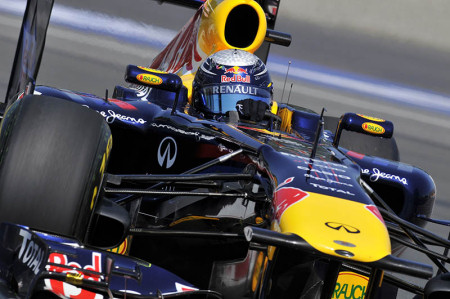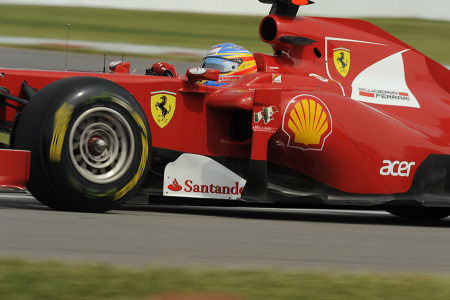The Way It Is/ F1's global growthby Gordon Kirby |
 Despite their disappointment in Abu Dhabi last weekend it's been a remarkable year for Sebastien Vettel and Red Bull Racing. With eleven wins and fourteen poles prior to the season closer in Brazil the young German and his team have dominated Formula One like no other driver in any form of the sport this year. Without doubt the Vettel era has arrived. The youngest F1 World Champion we've ever seen now has won two championships in a row and the sky appears to be the limit.
Despite their disappointment in Abu Dhabi last weekend it's been a remarkable year for Sebastien Vettel and Red Bull Racing. With eleven wins and fourteen poles prior to the season closer in Brazil the young German and his team have dominated Formula One like no other driver in any form of the sport this year. Without doubt the Vettel era has arrived. The youngest F1 World Champion we've ever seen now has won two championships in a row and the sky appears to be the limit.
Last year Vettel never led the points until the end of the season, stealing the world title from the grasp of teammate Mark Webber at the last race. But this year Vettel has dominated from the start, putting Webber and everyone else into the shade. Some people hoped for a mid-season slump from Red Bull and more progress from McLaren or Ferrari, but it didn't happen. The Red Bulls remained the cars to beat at almost every race challenged occasionally but never consistently by McLaren and Ferrari. Vettel made a handful of mistakes last year but he was darn near error-free this year. He's clearly matured over the past year or so but retains all of his youthful enthusiasm which is on clear display on the podium, in press conferences and with his yelping cheers whenever he takes another pole or win. It's a pleasure to see.  © Gary Gold Of course, chief designer Adrian Newey is a key element in Vettel and Red Bull's success. Newey has been designing successful racing cars for thirty years. After studying aeronautical engineering at Southampton University he went to work in 1982 as a junior draftsman at March Engineering. He worked as a race engineer in Formula Two, then worked with Al Holbert's team to develop March's IMSA GTP car. In 1984 Newey was assigned to work as Bobby Rahal's Indy car engineer and develop a new March Indy car for the following year. Newey and Rahal struck up an excellent working relationship and close friendship that continues to this day. "I've always said give me Adrian Newey and he'll design the best race car and we don't need the best driver to win," Rahal says. "Give him the money to design the best race car and you can take a driver for less money and win races. Give the driver $2 million and Adrian $9 million and you'll get a lot more value out of your money than by giving it all to the driver. If you've got the best race car you don't need the best driver." After his two years with Rahal, Newey engineered Michael Andretti's Kraco March Indy car in 1986, then joined Carl Haas's new Formula One team to design a turbo Ford-powered car for Haas. But Haas lost his sponsor and Newey spent the 1987 season working as Mario Andretti's race engineer at Newman/Haas. Andretti says Newey was a pleasure to work with. "Adrian was so methodical," Mario says. "At Indianapolis that year we were making fifty pound changes in spring rate just to dial the car into certain conditions and five minutes before the start of the race we changed front springs. We softened the front springs by fifty pounds. Adrian said, 'This is what we need to do.' You know, you never change the set-up at that stage of the game, but Adrian had a figure calculated right down to the ambient temperature and the amount of sun on the track. I had so much faith in him and we had tried all those combinations, so we made the change at the last minute. It was just amazing to have that combination of understanding between driver and engineer." Following his season with Newman/Haas Newey joined the Leyton House F1 team as chief designer, then moved to Williams where he worked with Patrick Head to design the championship-winning Williams-Renaults driven by Nigel Mansell in 1992 and Alain Prost in '93. Newey worked at Williams from 1991-'96, then joined McLaren where he worked through 2005 before joining Red Bull in 2006.  © Gary Gold Meanwhile, under Bernie Eccelstone's direction Formula One has continued its steady global expansion, adding races over the last ten years in Malaysia, Shanghai, Singapore, Abu Dhabi, South Korea and India. Turkey has come and gone while Ecclestone persists in trying to make Bahrain come back to life. Three of F1's biggest crowd-pulling races are the Canadian, Japanese and Austrlaian GPs. The Canadian GP began life as a sports car race at Mosport in 1961, became an F1 world championship round in 1967 and has been run regularly since 1978 at le Circuit Gilles Villeneuve in Montreal. The Australian GP's history goes back to 1928 and was first run as a round of the world championship in 1985 while Japan staged its first world championship race in 1976 and became a regular F1 fixture in 1987. But F1's base remains in its historic European races. The Italian GP at Monza started in 1922. The Belgian GP at the mighty Spa-Francorchamps circuit was first run in 1925. The German GP at the original Nurburgring started in 1927, Monaco in 1929 and Silverstone staged its first British GP in 1948. There's tremendous strength in these classic races which help provide F1 with a historical patina unrivalled in motor racing. Yes, IndyCar has the Indy 500, but its next oldest race is Long Beach not yet thirty years old as an Indy car race, and most other IndyCar races have been around for ten years or less. It's one of IndyCar's many failings.... Of course, F1 is slated to return to the USA next year in Austin, Texas. Ecclestone recently admitted there are troubles with two warring factions in Texas but added that he believes the race will happen. A second American race was announced last month for June of 2013 in Weehawken, New Jersey on a 3.2 mile street circuit beside the Hudson River with the Manhattan skyline in the background. New Jersey governor Chris Christie says no taxpayer or public money will be spent on the event and Weehawken GP founder Leo Hindery says he will pay both the towns of Weehawken and West New York for staging the race and for any costs incurred for using public facilities, services or personnel.  © Gary Gold Hindery says he expects 100,000 people on race day and believes the race will bring in $100 million in economic impact to the area. Hindery says the average cost of a three-day ticket will be $360. Grand Prix racing in America started at Sebring in 1959 and moved to Riverside the following year before settling into a home at Watkins Glen in 1961 for a much-remembered twenty year run. Then came a series of short-lived street or temporary circuit races starting at Long Beach from 1976-'83; Las Vegas in 1981 and '82; Dallas, 1984; Detroit, 1982-'88; and Phoenix for three unhappy years from 1989-'91. Tony George then made a deal with Ecclestone for F1 to race at Indianapolis from 2000-'07. A sad trail of failure it's been and it will be intriguing to see if Austin and Weehawken can reverse the tide or add to the legendary list of unsuccessful US GPs. Regardless of F1's future in the United States there's no doubt that Bernie Ecclestone's legacy will be that he made F1 into a truly global sport and increased its commercial value to unimagined heights. In the Ecclestone era many people have made fortunes out of F1 but nobody other than Bernie is privy to all the details of the TV and race contracts that fuel F1. When Ecclestone finally retires or passes on the vacuum created will be immeasurable. What will then happen? A power struggle of the most unseemly kind one would think. "Chaos," remarks my longtime friend and veteran F1 writer Nigel Roebuck. So be sure to enjoy the Vettel era and F1 as we know it today. Its great days may be numbered. |
Auto Racing ~ Gordon Kirby Copyright 2011 ~ All Rights Reserved |
